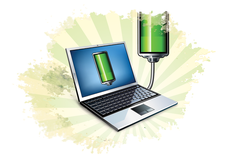Tools for checking ACPI battery data
Fully Charged

Linux offers some useful command-line tools that leverage the ACPI power management framework to display detailed data on the status of a laptop battery.
The quality of life for any laptop owner depends on the battery maintaining enough charge to operate off the power grid. Eventually, however, you will see a message informing you that the charge has reached a minimum threshold, and you have to save your data quickly or else switch to mains mode to continue working while the battery charges in the background.
The data for the warning message come from the Advanced Configuration and Power Interface (ACPI) [1] [2]. ACPI, which first appeared in 1996, has now replaced its predecessor, Advanced Power Management (APM); the current version 6 dates from April 2015. (For more information on APM and ACPI check out TuxMobil [3] and the ACPI how-to [4].)
ACPI used to be a separate component in Linux, but the Linux kernel developers now maintain ACPI functionality within the framework of the Unified Extensible Firmware Interface (UEFI) [5]. Linux comes with some command-line tools that let you read information on battery status and health. For Debian and its derivatives, you'll need the acpi, acpid, and acpi-support-base packages.
[...]
Buy this article as PDF
(incl. VAT)
Buy Linux Magazine
Subscribe to our Linux Newsletters
Find Linux and Open Source Jobs
Subscribe to our ADMIN Newsletters
Support Our Work
Linux Magazine content is made possible with support from readers like you. Please consider contributing when you’ve found an article to be beneficial.

News
-
Two New Distros Adopt Enlightenment
MX Moksha and AV Linux 25 join ranks with Bodhi Linux and embrace the Enlightenment desktop.
-
Solus Linux 4.8 Removes Python 2
Solus Linux 4.8 has been released with the latest Linux kernel, updated desktops, and a key removal.
-
Zorin OS 18 Hits over a Million Downloads
If you doubt Linux isn't gaining popularity, you only have to look at Zorin OS's download numbers.
-
TUXEDO Computers Scraps Snapdragon X1E-Based Laptop
Due to issues with a Snapdragon CPU, TUXEDO Computers has cancelled its plans to release a laptop based on this elite hardware.
-
Debian Unleashes Debian Libre Live
Debian Libre Live keeps your machine free of proprietary software.
-
Valve Announces Pending Release of Steam Machine
Shout it to the heavens: Steam Machine, powered by Linux, is set to arrive in 2026.
-
Happy Birthday, ADMIN Magazine!
ADMIN is celebrating its 15th anniversary with issue #90.
-
Another Linux Malware Discovered
Russian hackers use Hyper-V to hide malware within Linux virtual machines.
-
TUXEDO Computers Announces a New InfinityBook
TUXEDO Computers is at it again with a new InfinityBook that will meet your professional and gaming needs.
-
SUSE Dives into the Agentic AI Pool
SUSE becomes the first open source company to adopt agentic AI with SUSE Enterprise Linux 16.

